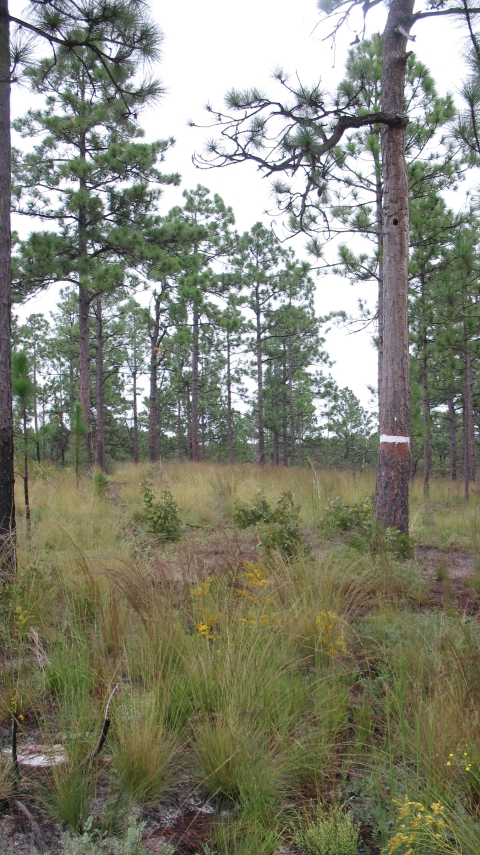About Us
The refuge was established on March 17, 1939 to provide habitat for migratory birds, to demonstrate sound management practices that enhance natural resource conservation, and to provide wildlife-oriented recreation opportunities. The Federal government purchased land from willing sellers. Much of the land was eroded from poor farming and forestry practices and supported few populations of wildlife species; initial conservation efforts focused on restoring the barren land.
Located in the Sandhills Physiographic Region of South Carolina, the Carolina Sandhills NWR is one of the Southeast’s premier sites for viewing the longleaf pine/wiregrass ecosystem and is comprised of 47,850 acres, including fee ownership of 45,348 acres, and nine conservation easements totaling 2,502 acres. The majority of the refuge lies in Chesterfield County, South Carolina. There is one fee title tract totaling 210 acres in Marlboro County. Numerous small creeks and tributaries, along with thirty man-made lakes and ponds and 1,200 acres of fields, support a diversity of habitats for wildlife.
Along with rolling sand hills, the refuge is home to streamside pocosins (translated “swamp on a hill”), open fields, hardwood ridges, wetlands and open water ponds. This mosaic of habitats provides for the needs of more than 190 species of birds, 42 species of mammals, 41 species of reptiles, and 25 species of amphibians. More than 1,000 species of plants have been identified on the refuge, including rare species of pitcher plants, Well’s pixie-moss, and the white-wicky. The refuge supports a secondary recovery population of the red-cockaded woodpecker and numerous species of pine-grassland birds, including Northern bobwhite quail, Bachman’s sparrow, Chuck-will’s-widows, and American Kestrel.
Our Mission
Each unit of the National Wildlife Refuge System is established to serve a statutory purpose that targets the conservation of native species dependent on its lands and waters. All activities on those acres are reviewed for compatibility with this statutory purpose.
The Carolina Sandhills NWR was established by Executive Order 8067 in 1939. Additional lands were added to the refuge under the Migratory Bird Conservation Act and the Fish and Wildlife Act of 1956.
For lands acquired under Executive Order 8067, dated March 17, 1939, the purpose of the acquisition is “as a refuge and breeding ground for migratory birds and other wildlife.”
For lands acquired under the Migratory Bird Conservation Act, 16 USC, Subpart 715-715Y, as amended, the purpose of the acquisition is “for use as an inviolate sanctuary, or for any other management purpose, for migratory birds.” 16 USC, Subpart 715d (Migratory Bird Conservation Act).
For lands acquired under the Fish and Wildlife Act of 1956, 16 USC, Subpart 742 (a) - 754, as amended, the purpose of the acquisition is “for the development, advancement, management, conservation, and protection of fish and wildlife resources,” [16 USC, Subpart 742 (a) (4)], “for the benefit of the United States Fish and Wildlife Service, in performing its activities and services. [16 USC, Subpart 742f (b) (1)].
Vision
The call of the bobwhite quail beckons the visitor to explore the expansive, rolling longleaf pine landscape found on Carolina Sandhills National Wildlife Refuge. Lying between the Piedmont and the Coastal Plain, the refuge demonstrates sound forest and wildlife management that support a recovered red-cockaded woodpecker population, an abundance of migratory birds, and a diversity of plants and animals that flourish in this fire-shaped ecosystem. The sounds of solitude, contrasting hues and varied textures of native wildflowers, grasses, and trees awaken the senses and stir the soul. Refuge stewards, including staff, neighbors, partners, and volunteers, work collaboratively to understand, protect, and restore biological communities. Wildlife-compatible recreation and environmental education opportunities promote a strong conservation ethic and foster a greater understanding and appreciation of the longleaf pine ecosystem and mission of the National Wildlife Refuge System.
To fulfill the vision and purposes of the refuge, the Comprehensive Conservation Plan for Carolina Sandhills NWR (U.S. Fish and Wildlife Service 2010) identifies the following management goals:
1) Conserve, manage, and restore populations of native plant and animal species representative of the sandhills longleaf pine ecosystem with special emphasis on migratory birds and threatened and endangered species.
2) Conserve, manage, and restore representative refuge habitats with emphasis on longleaf pine forests and associated native groundcover, sandhill streams and bogs, and grassland openings.
3) Identify and conserve archaeological and natural resources and promote conservation through interagency and private landowner cooperation, partnerships and land protection programs.
4) Provide quality environmental education and interpretation programs, outreach opportunities, and wildlife-compatible recreational activities that lead to enjoyment and a greater understanding of, and appreciation for, Carolina Sandhills NWR, wildlife, and habitats.
Our History
After establishment, the Federal government purchased land and immediately began restoration efforts. This included planting trees, farming, soil stabilization, creating wetland impoundments and green tree reservoirs, and stocking fish and wildlife. Over time, additional responsibilities were added for restoring and enhancing longleaf pine habitat for the benefit of the red-cockaded woodpecker, named as an endangered species in 1970. The refuge provides environmental education and interpretation of its work. Habitat improvement and restoration of native plant communities, monitoring the populations of red-cockaded woodpeckers and other grassland-pine species, and assessing the impacts of management actions on wildlife species and habitats are critical elements in the refuge's operations.
Other Facilities in this Complex
Carolina Sandhills National Wildlife Refuge is managed as part of the Carolina Sandhills National Wildlife Refuge Complex.





